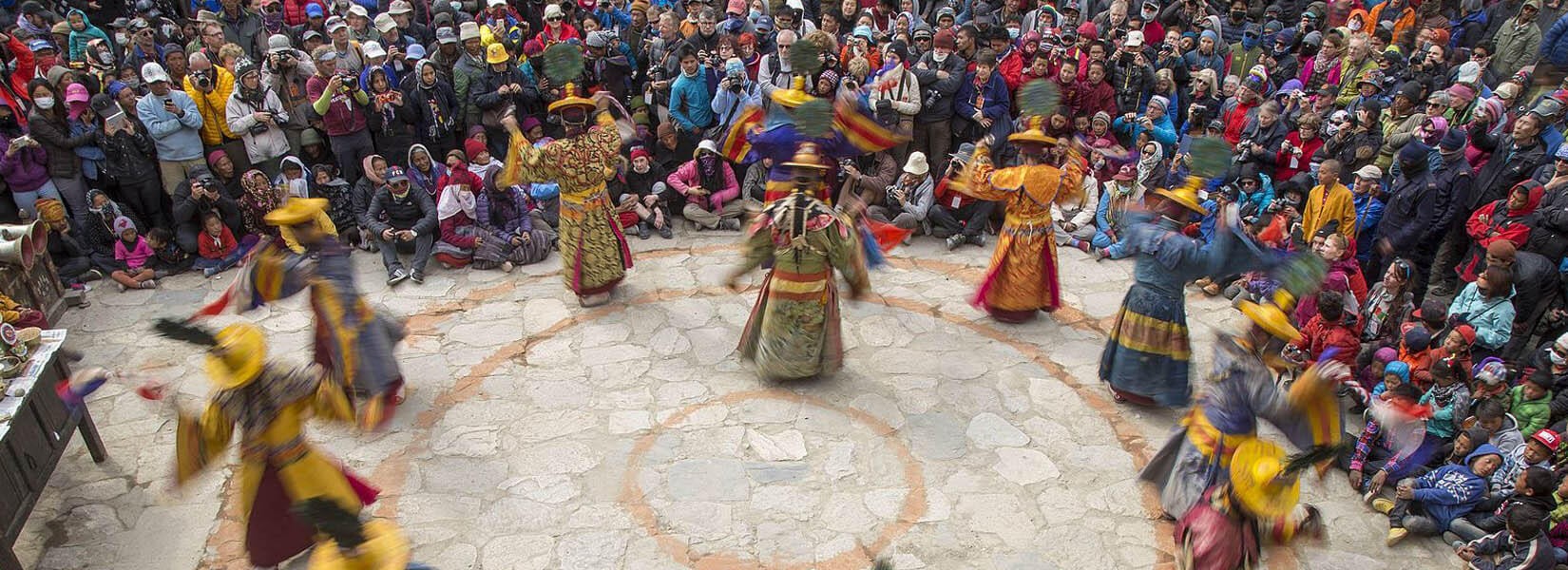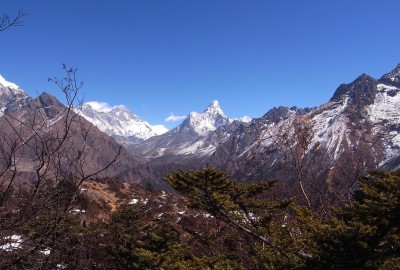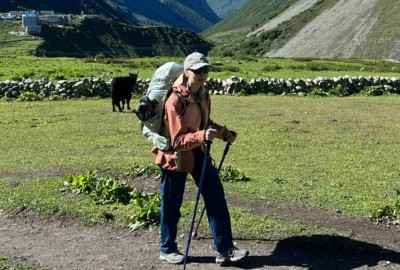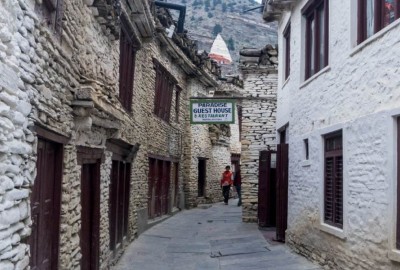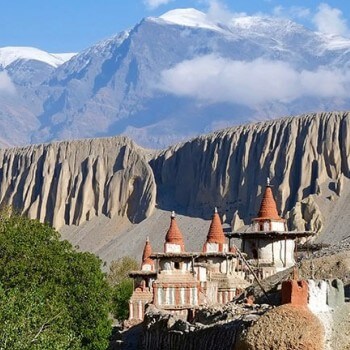True purpose makes travel meaningful and a lot less arduous. On a Nepal tour, we take goals one at a time. You are now only a few miles away from fulfilling today’s mission- making it to the Upper Mustang Tiji Festival. It is going to be a riveting experience.
Table of Contents
Plan your trip to Nepal
Customize your trip with help from a local travel specialist.
Upper Mustang is Nepal’s unspoiled terrain staring down from its roof. When you’re in Upper Mustang, it’s almost as if you are staring down at the world. At this moment, your feet are at an incredible altitude of over 3500 meters, and nothing else matters. You’re a little worn out, but almost there. As you start walking further, you begin to hear hymns and chants and prayers. That is the sound of the Mustang Tiji Festival at a fair distance.
The patience you’ve shown is starting to look like it will pay off. The prayers are slowly beginning to sound louder. The trails now look gleeful and welcoming. The most auspicious occasion of the entire region and you get to be a part of it. How about that?
The Mustang tour has increasingly grown in popularity among national and international tourists. “The Forbidden Kingdom” is now a captivating destination that presents rare scenic beauty. It is a must-see place in almost every traveler’s list. Towards the northernmost of Mustang lies a preserved “isolated region.” Although not as often talked about, the Upper Mustang tour is one that will stay with you long after you leave.
Upper Mustang distinguishes itself with its unique topography- high walls, a deserted grandeur, and lifeless terrains. Imagine yourself in the middle of this dry, beautiful, daunting terrain. Your feet are at a height you never believed they were capable of attaining. And yet, no other experience has come closer to what you have absorbed by now. Soak it in; you’ve earned it.
What drives you to conquer this feat? What entices you to set out on every great journey you plan? The answer may well be- purpose.
True purpose makes travel meaningful and a lot less arduous. On a Nepal tour, we take goals one at a time. You are now only a few miles away from fulfilling today’s mission- making it to the Upper Mustang Tiji Festival. It is going to be a riveting experience.
Let’s hop in and find out what makes the Mustang Tiji festival so mesmerizing.
Background and History of Mustang Tiji Festival
Tiji, also known as “Tenchi” is the biggest annual festival celebrated in Upper Mustang. It has a rich historical background and a symbolic significance in Nepalese civilization. It has also helped place Upper Mustang atop the league of serious trek destinations.
The occasion centers on Lo Manthang of Upper Mustang, its primary point of attraction. Local people from neighboring areas gather in the courtyard of Tashi Gephel Palace, where monks perform the famous “Vajrakila” rituals across three days.
The history of the Mustang Tiji Festival goes way back to the 17th century. Mustang then was an independent kingdom with close ties to Tibet. The then King of Mustang Samdup Rabten invited Sakya Trizin Ngawang Kunga Sinam in Lo Manthang. During Sakya’s brief stay Lo-Manthang Chhode Monastery, he performed a special Vajrakila ritual. The ritual advocates the well-being of Mustang, destroying all the negative influences.
It celebrates the victory of Dorje Jono over the demon which had taken upon Mustang then. The monks of Chhode monastery have inherited this ancient practice over centuries. Now, they perform these rituals each year.
The name of this ritual first emerged from the Buddhist term Tenpa Chirim. The meaning of the name implied the benefits of Buddha’s teaching for the well-being of all. Vajrakila practice though was already widespread in India, Tibet, and even Nepal before. Early on in the 8th century AD, Buddhist master from Nepal Padmasambhava, Vimalamitra and Shilamnju were responsible for introducing this practice in Tibet. Padmasambhava even contributed to some crucial steps in the sacred dance of Vajrakila at Samye Monastery in Tibet.
Later on, there was substantial evidence of Vajrakila practiced in Tibet across centuries. Sakyapa school of Tibetan Buddhism is best known for popularizing the Khon tradition Kila (Phurba) among others. It is surprising how the Mustang Tiji festival has survived hundreds of lineages and still retained its originality.
When they celebrate it
People celebrate the Mustang Tiji festival in May every year. The dates are different for each year. The festival lasts for three days in a timely procession. If you’re planning on being there for the festival, it’s best that you schedule your itinerary for the month of May.
How they celebrate Mustang Tiji Festival
As breathtaking as the setup is, its execution is demanding. It is always a geographical challenge achieving anything at that altitude. The build-up to the Tiji festival is not a piece of cake, particularly for the performer. The lead dancer (Tsowo) retreats to a 3-month long meditation prior to the main event. This retreat is an essential step in the preliminary stage of the festival. There are three different stages in the main event of Mustang Tiji festival. Each day in the festival qualifies as one of the three stages.
First Day: Drums, Thangka, and Beginning of the Ritual
The first day of the Upper Mustang Tiji festival is almost like a setup. The monks along with the offerings gather around in Chhode Gompa monastery. You will get to observe the Vajrakila prayers from the monks first thing in the morning. During the afternoon, they unveil a 400-year-old hand-embroidered “Thangka” painting of Padmasambhava along with his two dakinis. The sounds of drums, cymbals, and long copper horns welcome the art to the courtyard.
The offerings include six bowls of grain and torma served on a wooden altar. Esteemed monks in red hats arrive at the scene and sit beneath the thangka. The “Khempo,” who is the chief of the Chhode Gompa rightfully sits on a higher arena.
While the King sits in his private room, the dancers dance to his attention. The Tsowo, the lead dancer, is the most recognizable one during this performance. The procession moves downstairs, where the rest of the audience is waiting for them. The dance, consisting of around 52 steps, is first slow and watchful. It gets fierce the next day, signaling the awakening of gods and purification of the land. Tsowo guides his performers through gestures and notions, but it is too subtle for us to notice. The entire scenario is lit up with sound, colors, and aroma. The first day marks fascinating details that prepare you for the rest of the festival.
Second Day: Purification and the End of Evil
Almost a similar routine of the monks gathering in the square begins the second day. They chant the Vajrakila prayers and practice offerings. They introduce another large thangka painting and place it near the previous one. You’ll notice the dance steps become aggressive with weapons and animal forms also in the mix. Towards the end, the Tsowo releases a dagger symbolizing the end of the evil. The Tsowo fires the knife at a straw statue and later tosses it up in the air. Just like Dorje Shunu, the Tsowo re-enacts the slaying of the demon. These actually indicate how people will take almost any measure to survive the worst.
Third-Day: Conclusion of the Rituals
Again, on the third day, the monks assemble in the square of the monastery, make offerings and prayers to Vajrakila. Once again, the monks perform the dances in animal forms. The Tsowo caters special nectar as blessings from the gods. The ritual heads towards a conclusion as the dancers lead the way to escort the King and his family.
The King exchanges greetings with the Khenpo as well as the rest of the monks. Local people pray and make offerings on being lucky to witness yet another Tiji festival. They express their gratitude among performers and hail the leader. The night is going to be a long one for the dancers.
How to Get to Lo Manthang
There are two ways you could get to Lo Manthang for the Mustang Tiji festival.
1. By flight: Fly from Pokhara to Jomsom. Walk or drive from Jomsom to Kagbeni. From Kagbeni which is the window to Upper Mustang, you can drive to Lo Manthang. It is where you get to see the Tiji festival. Acclimatize gradually as the altitude is quite high.
2. By trekking: Once you get to Kagbeni, you have the option to trek all the way to Lo Manthang, which is quite a strenuous one. Walk from Kagbeni to Chele (5-6 hrs), then Chele to Syanbochen (6-7 hrs), Syanbochen to Ghaymi (5-6 hrs), and from Ghaymi to Charang (4-5 hrs). From Charang, you can get to Lo Manthang on approximately the 9th day of your Tiji festival trek.
Significance of Mustang Tiji Festival
Like most festivals in Hinduism and Buddhism, the Mustang Tiji festival represents the victory of good over evil. Vajrayana Buddhism depicts the bravery of Dorje Jono, the demon slayer. The festival reads like a great chapter not just in Nepalese mythology but also in Nepal’s history. The festival wishes mutual prosperity for all sentient beings. A variety of exciting rituals, dances, prayers, and colors are the highlights of the occasion. Above all, to have such vibrancy come from a place that remote is praiseworthy.
The festival has become a medium for the people of Mustang to unite, share offerings, and prayers. Every year, people of Mustang rejoice in honoring their ancestral heroics and legend. It is a legend they believe in gracefully. After all, there’s a thin line between belief and ignorance. The people in Mustang choose the former and take pride in it. Somewhere behind those masked dancers, blurry smoke, and faint hymns, there is an unvoiced joy of triumph. The Mustang Tiji festival is a momentous celebration of this triumph that resonates among the people.
Need Help Planning a Trip to Nepal?
Feel free to contact us, if you need any help planning your trip to Nepal. Our local travel experts will design a custom-made itinerary based on your time, group, cost, and other requirements.

